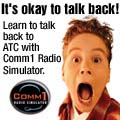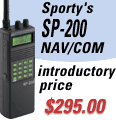| Advertisers
     
Do not reply to this e-mail. Got news? Contact ePilot. Having difficulty using this service? Visit the ePilot Frequently Asked Questions now at AOPA Online or write to [email protected].
Aircraft Owners and Pilots Association
421 Aviation Way
Frederick, MD 21701
Tel: 800/USA-AOPA or
301/695-2000
Copyright � 2002 AOPA. | Training Tips
| SETTING THE COURSE
 The go/no-go decision is "go." The flight has launched. As you reach cruising altitude, you shift focus from the maximum-performance realm of takeoff and climb to the power-management and navigational tasks awaiting in cruise. You've been told to "Proceed on course" by an air traffic controller, or you have departed the immediate area of your nontowered field. In either case, you must intercept and establish yourself on your departure course, find your first checkpoint, and verify your previously calculated groundspeed estimates. Now that it's winter, many pilots will have to take necessary safety precautions for cold-weather operations. For a wealth of information, review articles available on AOPA Online. Consult your pilot's operating handbook for make- and model-specific procedures. The go/no-go decision is "go." The flight has launched. As you reach cruising altitude, you shift focus from the maximum-performance realm of takeoff and climb to the power-management and navigational tasks awaiting in cruise. You've been told to "Proceed on course" by an air traffic controller, or you have departed the immediate area of your nontowered field. In either case, you must intercept and establish yourself on your departure course, find your first checkpoint, and verify your previously calculated groundspeed estimates. Now that it's winter, many pilots will have to take necessary safety precautions for cold-weather operations. For a wealth of information, review articles available on AOPA Online. Consult your pilot's operating handbook for make- and model-specific procedures.
Cross-country flying is an exhilarating stage of training that is integrated with the rest of the training curriculum. Now, the practicality and unparalleled enjoyment of an airplane as a traveling machine emerge. Those ground school and home-study sessions on navigation begin to shape your hands-on flying. You visit other airports and fly above new terrain.
You learn from the outset that the reality of a particular flight may vary somewhat from the expectations born of your careful planning, and you constantly adjust for that difference. For example, winds or weather may vary. Or your departure may require vectors around other aircraft before being released to "resume your own navigation," requiring you to intercept your course from an unexpected point in space--no problem if you are familiar with your local area and using the aeronautical charts designed for your kind of flying (see AOPA's Chart User's Guide). Download the navigational tasks to be mastered for the Private Pilot Flight Examination, as well as flight-planning and lost-procedures techniques, in the Practical Test Standards. And for a fascinating look at how a brand-new student pilot used these techniques, as well as some superb good judgment, to resolve her uncertainty during her second solo cross-country flight, read her tale.
Have a great flight!
| Accessing AOPA Online
| As an AOPA Flight Training Trial Member, you have access to all of the features within AOPA Online. If you have received a copy of the magazine or your membership credentials in the mail, log in using your eight-digit member number, which is also your username. If you have not yet received your number, please call AOPA Member Assistance at 800/872-2672 weekdays between 8:30 a.m. and 6 p.m. Eastern for assistance.
| Flight Training News
| WRIGHT FLYER DIFFICULT TO FLY
Do you ever find your training aircraft hard to fly? Pity the Wright brothers, who taught themselves how to fly. Engineers are discovering that the Wrights' early airplanes were very difficult to control. Engineers from the American Institute of Aeronautics and Astronautics (AIAA) in Los Angeles are talking with their counterparts at NASA's Dryden Flight Research Center about flying a replica of the Wright brothers' first powered airplane at Dryden's facility on Edwards Air Force Base in California's Mojave Desert, where some of the nation's hottest new aircraft are tested. With a cruise speed of less than 30 knots, it won't be the fastest thing on the runway, but it may be the most difficult to fly of most of the aircraft previously tested there. Last year, pilots and engineers found they could barely control a simulator rigged to fly with the characteristics of the Wright Flyer. Testing could occur by mid-2002.
SMALL WORLD FOR SWISS AVIATORS
Romana Wolf and Catherine Frei, from different parts of Switzerland, both decided to become commercial airline pilots–but never met until they found themselves sitting beside each other, on a flight to the United States. Both had enrolled in the aviation program at Daniel Webster College in Nashua, New Hampshire. Now roommates, they begin their senior years at the college this month. They were featured recently in The Nashua Telegraph . And despite the events of September 11, both hope to become commercial airline pilots after graduating in December.
| Inside AOPA
| AOPA DEFENDS GA IN 'USA TODAY'
AOPA countered an editorial in the December 31 USA Today with a sharply worded opinion piece of its own. "A drastic increase in security at small general aviation airports is unnecessary," said the AOPA response, signed by AOPA President Phil Boyer. "Congress, the Department of Transportation, the Federal Aviation Administration, and the aviation community support this premise. So what does USA Today know that these people don't?" For more information, see AOPA Online.
Changing your mailing or e-mail addresses? Click here to update.
| Training Products
| FLIGHT COMPUTER FOR PDAs
Did you receive a Palm-compatible personal digital assistant (PDA) as a holiday gift? If so, you can put it to work in your flying with the recently released CX-2-Palm Pathfinder software from Aviation Supplies and Academics. The flight-computing software includes 34 aviation functions and 18 unit-conversion functions, among other features. The CX-2-Palm Pathfinder lists for $39.95; to order call ASA at 800/ASA-2-FLY or visit the Web site.
| Final Exam
| Question: On the sectional chart I use, there is a small letter "T" in a circle in the upper right corner of the information box for one of the local VORs. What does it mean?
Answer: In this case, the letter "T" stands for Transcribed Weather Broadcast (TWEB), which is a continuous recording of meteorological and aeronautical information that is broadcast for pilots over the VOR's navigation frequency. Sometimes, you may see the letter "H" inside a circle. This stands for Hazardous Inflight Weather Advisory Service (HIWAS). HIWAS is a continuous recorded hazardous inflight weather forecast that is broadcast to airborne pilots over selected VOR outlets. For information on charts and charts symbols, refer to the Aeronautical Chart User's Guide available on AOPA Online.
Got a technical question for AOPA specialists? E-mail to [email protected] or call 800/872-2672.
| Coming Soon in AOPA Flight Training
| Master your understanding of the six basic flight instruments, learn how to manage the mixture control, and find out how to avoid controlled flight into terrain by reading the February 2002 issue of AOPA Flight Training, which is scheduled to be mailed this weekend.
| What's New At AOPA Online
| AOPA HOME PAGE GETS NEW LOOK
AOPA Online's home page has a fresh new look. In addition, navigation has been enhanced with buttons featuring pop-up menus on the left side and top of the page, helping you to select more easily from among AOPA's many online resources. Try it for yourself.
| Picture Perfect
| | Jump to the AOPA Online Gallery to see the featured airplane of the day. Click on the link for details on how to capture wallpaper for your work area. See AOPA Online. | ePilot Calendar
| Check your weekend weather on AOPA Online.
WEEKEND FLYING DESTINATIONS
East Lansing, Michigan. The Great Lakes International Aviation Conference takes place January 18 through 20 at the Kellogg Hotel and Conference Center. Call 517/335-9880 for event information.
For more airport details, see AOPA's Airport Directory Online . For more events, see Aviation Calendar of Events
ASF FLIGHT INSTRUCTOR REFRESHER CLINICS
(All clinics start at 7:30 a.m.)
The next AOPA Air Safety Foundation Flight Instructor Refresher Clinics are scheduled in Jacksonville, Florida, and Detroit, Michigan, January 12 and 13. For the Flight Instructor Refresher Clinic schedule, see AOPA Online.
ASF PINCH-HITTER GROUND-SCHOOL COURSES
(Pinch-Hitter courses start at 9:30 a.m.)
The next Pinch-Hitter� Ground Schools will take place January 6 in Long Beach, California, and San Antonio, Texas; and on February 3 in Dallas, Texas. For more Pinch-Hitter courses, see AOPA Online.
ASF SAFETY SEMINARS
AOPA Air Safety Foundation Safety Seminars are scheduled in Californis: Oakland, January 7; Santa Rosa, January 8; Sacramento, January 9; Fresno, January 10; Van Nuys, January 14; Ontario, January 15; Carlsbad, January 16; and Costa Mesa, January 17. The topic is Spatial Disorientation. For more information, visit the Web site.
For comments on calendar items or to make submissions, contact Julie S. Walker at [email protected].
| |